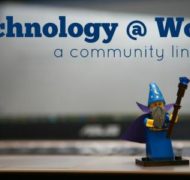Technology at Work: Technology in the Classroom
Blog / Produced by The High Calling
When I was in high school, I learned to type on a typewriter.
I’m part of the last generation to remember the classroom without computers—not only as a student, but also as a teacher.
When I started teaching English to middle school students, I placed my overhead-projector at the front of the classroom, and I had a plethora of plastic transparencies and erasable markers within easy reach. This allowed me to face my students while writing on the overhead.
I used to wait days, sometimes weeks, for curriculum resources to arrive by mail. When my teaching materials eventually landed on my doorstep, I’d spend hours cutting and pasting the handouts and literature pieces I wanted to use. And when I say “cutting and pasting,” I mean with actual scissors and tape.
To determine final grades for report cards, I’d stay up half the night dutifully pecking out numbers on a calculator.
Then I semi-retired.
In other words, I got married, had babies, and spent the next decade at home with my little ones.
Once all my children were school-age, I returned to classroom—and discovered everything had changed.
A Smart-Board replaced the overhead-projector, so when I type on the computer, my words automatically appear on the screen behind me. I can also peruse countless teaching materials online, and with a few clicks, I can instantly download curriculum resources. These downloads are interactive PDFs too, which allows me to customize my own materials. Cutting and pasting has taken on a whole new meaning.
Not only that, but report cards have never been easier. I simply enter the numbers into a spreadsheet program designed for teachers. And voila! The final grade is calculated for me.
The convenience of technology in the classroom is undeniable, yet the benefits come with potential detriments too.
The landscape of the classroom has changed. It’s not just the Smart-Board on the wall or the computer on my desk that’s different either. Students come to school armed with smartphones, and they’d rather have their eyes on their screens than anything else. And it’s easy to see why many students perceive their teachers as obsolete.
When students have a question, adults—such as parents and teachers—are no longer the primary go-to sources. Students just ask Siri.
When students want to learn something new, books—the kind with paper and binding—are no longer the primary resources. Students just use Google.
The technology at students’ fingertips makes it increasingly difficult for students to remain “fully present” in the classroom when they can easily wander off into an electronic nether-land—without ever leaving their desks.
The biggest difference I’ve observed with technology in the classroom, however, is the communication with parents. In the “old days,” if a parent had a question or a concern, they would call and leave a message. So I would use the phone in the teachers’ lounge to return calls after school.
Nowadays, virtually all communication happens via email, which is quick and convenient. Most of the time. But when there’s a more serious concern? Phone calls are still a better way to go. And if it’s a really serious concern? A parent-teacher meeting is preferable. For that’s when you can see each other’s eyes and hear each other’s voices.
Email makes it all too easy for a parent to fire off an angry email, when in all likelihood it was a simple misunderstanding somewhere between child-and-parent or student-and-teacher.
For all the benefits technology affords us, the greatest detriment is its inherent ability to forget that a human being resides on the other side of the screen. And while students may sometimes feel that teachers have become obsolete—since we’re not exactly needed for information purposes—students still benefit from human connection. I see evidence of this every day.
A computer can’t hand a paper back to a student and say, “You have a gift with words.” But a teacher can be an instrument of hope and encouragement.
Yes, the landscape of the classroom has changed, and as a teacher, I am thankful for the benefits and mindful of the potential detriments that technology brings. But if there is one thing I have learned from my years in the classroom, it’s that human warmth can never be replaced with mere technology. And it’s human warmth, more than technology, that’s the betterment of us all.
 Denise J. Hughes is a professor of English and editorial coordinator at incourage.me. She’s the founder of Deeper Waters, a ministry devoted to spiritual formation, where women can gather and grow deeper together. At her blog, Embracing Grace and Truth, she writes about faith, motherhood, and writing. This post originally appeared on Denise's blog, and was submitted as part of our community linkup for the theme: Technology at Work.
Denise J. Hughes is a professor of English and editorial coordinator at incourage.me. She’s the founder of Deeper Waters, a ministry devoted to spiritual formation, where women can gather and grow deeper together. At her blog, Embracing Grace and Truth, she writes about faith, motherhood, and writing. This post originally appeared on Denise's blog, and was submitted as part of our community linkup for the theme: Technology at Work.





